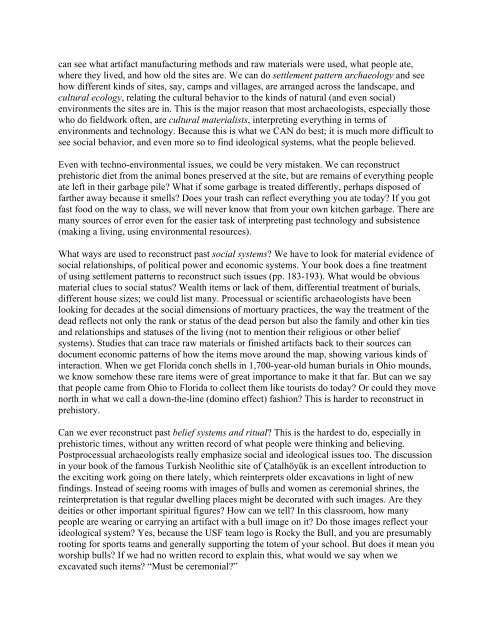INTRODUCTION TO ARCHAEOLOGY Nancy White - Touro Institute
INTRODUCTION TO ARCHAEOLOGY Nancy White - Touro Institute
INTRODUCTION TO ARCHAEOLOGY Nancy White - Touro Institute
You also want an ePaper? Increase the reach of your titles
YUMPU automatically turns print PDFs into web optimized ePapers that Google loves.
can see what artifact manufacturing methods and raw materials were used, what people ate,<br />
where they lived, and how old the sites are. We can do settlement pattern archaeology and see<br />
how different kinds of sites, say, camps and villages, are arranged across the landscape, and<br />
cultural ecology, relating the cultural behavior to the kinds of natural (and even social)<br />
environments the sites are in. This is the major reason that most archaeologists, especially those<br />
who do fieldwork often, are cultural materialists, interpreting everything in terms of<br />
environments and technology. Because this is what we CAN do best; it is much more difficult to<br />
see social behavior, and even more so to find ideological systems, what the people believed.<br />
Even with techno-environmental issues, we could be very mistaken. We can reconstruct<br />
prehistoric diet from the animal bones preserved at the site, but are remains of everything people<br />
ate left in their garbage pile? What if some garbage is treated differently, perhaps disposed of<br />
farther away because it smells? Does your trash can reflect everything you ate today? If you got<br />
fast food on the way to class, we will never know that from your own kitchen garbage. There are<br />
many sources of error even for the easier task of interpreting past technology and subsistence<br />
(making a living, using environmental resources).<br />
What ways are used to reconstruct past social systems? We have to look for material evidence of<br />
social relationships, of political power and economic systems. Your book does a fine treatment<br />
of using settlement patterns to reconstruct such issues (pp. 183-193). What would be obvious<br />
material clues to social status? Wealth items or lack of them, differential treatment of burials,<br />
different house sizes; we could list many. Processual or scientific archaeologists have been<br />
looking for decades at the social dimensions of mortuary practices, the way the treatment of the<br />
dead reflects not only the rank or status of the dead person but also the family and other kin ties<br />
and relationships and statuses of the living (not to mention their religious or other belief<br />
systems). Studies that can trace raw materials or finished artifacts back to their sources can<br />
document economic patterns of how the items move around the map, showing various kinds of<br />
interaction. When we get Florida conch shells in 1,700-year-old human burials in Ohio mounds,<br />
we know somehow these rare items were of great importance to make it that far. But can we say<br />
that people came from Ohio to Florida to collect them like tourists do today? Or could they move<br />
north in what we call a down-the-line (domino effect) fashion? This is harder to reconstruct in<br />
prehistory.<br />
Can we ever reconstruct past belief systems and ritual? This is the hardest to do, especially in<br />
prehistoric times, without any written record of what people were thinking and believing.<br />
Postprocessual archaeologists really emphasize social and ideological issues too. The discussion<br />
in your book of the famous Turkish Neolithic site of Çatalhöyük is an excellent introduction to<br />
the exciting work going on there lately, which reinterprets older excavations in light of new<br />
findings. Instead of seeing rooms with images of bulls and women as ceremonial shrines, the<br />
reinterpretation is that regular dwelling places might be decorated with such images. Are they<br />
deities or other important spiritual figures? How can we tell? In this classroom, how many<br />
people are wearing or carrying an artifact with a bull image on it? Do those images reflect your<br />
ideological system? Yes, because the USF team logo is Rocky the Bull, and you are presumably<br />
rooting for sports teams and generally supporting the totem of your school. But does it mean you<br />
worship bulls? If we had no written record to explain this, what would we say when we<br />
excavated such items? “Must be ceremonial?”
















